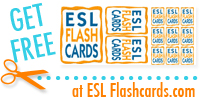|  |
Teaching of Reading
The most successful reading programs combine elements of both the "look-say" approach and the phonetic approach.
Eric
Apr 3rd, 2005
|
| | There are basically two different common methods of teaching reading. One usually refers to whole language approach("look say"), the other usually refers to phonetics approach. The tension between these two approaches often refers "the great debate". Lately, some researchers purpose a balanced approach, aims to intergrate two approaches.
A "look say" method introduces rigidly selected vocabularies in progressive texts. Students memorize the appearance of words, or learn to recognize words by looking at the first and last letter. Students taught to read by the "look say" method are not taught to pronounce new words. It is known that "look say" students do not naturally learn to spell or write unless explicitly taught. However, they can learn the 5,000 most common words in roughly three years. This is sufficient for basic literacy. The classic implementation of this approach was the McGill reading curriculum used to teach most baby boomers to read in the U.S.
"Look say" is the same method used to acquire literacy in languages such as Chinese, based on ideograms.
A "phonetic" method teaches sounds to be associated with letters and combinations of letters. Students memorize these associations. They learn to sound out and then blend sound combinations to produce words. This method requires direct teaching of "sounding out" methods, and memorization of pronunciation rules. The most perfect phonetic system is Orton phonography, originally developed to teach brain-damaged adults to read. Orton described 73 "phonograms", or letter combinations, and 23 rules for spelling and pronunciation. By following these rules one can correctly pronounce and spell all but 123 of the 13,000 most common English words.
Advocates of "look say" teaching argue that it is the method used by literate adults to read all familiar words. Also the method is said to be easy to teach, and pleasant for students. Critics charge that a "look say" student can only speak and spell words that they have been taught, therefore, the critic says, they are permanently crippled when compared to phonetically-taught students. Also, it is established that this method requires an expensive set of textbooks for each student. It is therefore very popular with textbook companies. Critics have charged that for this reason, book companies may have found methods to biase experts and institutions to favor this method.
Advocates of phonetics cite the large reading and spelling vocabulary that phonetic students can theoretically obtain. However, critics of phonetic methods talk of students that fail at each one of the method's many mandatory skills. Almost all students learn letter-sounds. Many students find it difficult to "blend" the letter sounds to produce sensible speech. Some students also fail to apply rules to select letter sounds. Also, critics charge that in phonetic programs, students can learn to pronounce a sentence without ever learning to understand it. The same, of course, holds true for "look say".
In practice, the most successful reading programs combine elements of both. For example, the extremely popular book, Teach Your Child to Read in 100 Easy Lessons, by Siegfried Engelman, et al. (ISBN 0-671-63198-5), teaches pronunciation and simple phonetics, then supplements it with progressive texts and practice in directed reading. The end result of a mixed method is a casually phonetic student, a much better first-time pronouncer and speller, who still also has look-say acquisition, quick fluency and comprehension. Using an eclectic method, students can select their preferred learning style. This lets all students make progress, yet permits a motivated student to use and recognize the best traits of each method.
Speed reading continues where basic education stops, and teaches the student to read multiple words at once, even whole pages at once. Usually after some practice reading speed can be increased fivefold. At this speed, it is necessary to stop any "talk to myself" action in your brain, because this would slow you down. There are various speedreading techniques. Hopify ( http://www.freesoftware.fsf.org/hopify/) is a GPL tool to practice speedreading.
Readability indicates the ease of understanding or comprehension due to the style of writing. Reading recovery is a method for helping students learn to read. Source: http://en.wikipedia.org/wiki/Teaching_of_Reading |
| | | | |
I find that my students naturally use both methods, even though I teach the "phonetic" style. I know this because often they will see a word that they haven't seen before (e.g. Toronto) and they'll read it as a word they do know with the same first and last letter (e.g. tomato). | | | Eric18
on
Oct 20th, 2007, 12:48 am
|  Re: Teaching of Reading Re: Teaching of Reading
Thank you for this solid primer of a passionate debate among reader teachers and ESL professionals. The inclusion of relevant texts also added useful tips so we could continue to research the topic. Quote:
Quote Eric  There are basically two different common methods of teaching reading. One usually refers to whole language approach("look say"), the other usually refers to phonetics approach. The tension between these two approaches often refers "the great debate". Lately, some researchers purpose a balanced approach, aims to intergrate two approaches.
A "look say" method introduces rigidly selected vocabularies in progressive texts. Students memorize the appearance of words, or learn to recognize words by looking at the first and last letter. Students taught to read by the "look say" method are not taught to pronounce new words. It is known that "look say" students do not naturally learn to spell or write unless explicitly taught. However, they can learn the 5,000 most common words in roughly three years. This is sufficient for basic literacy. The classic implementation of this approach was the McGill reading curriculum used to teach most baby boomers to read in the U.S.
"Look say" is the same method used to acquire literacy in languages such as Chinese, based on ideograms.
A "phonetic" method teaches sounds to be associated with letters and combinations of letters. Students memorize these associations. They learn to sound out and then blend sound combinations to produce words. This method requires direct teaching of "sounding out" methods, and memorization of pronunciation rules. The most perfect phonetic system is Orton phonography, originally developed to teach brain-damaged adults to read. Orton described 73 "phonograms", or letter combinations, and 23 rules for spelling and pronunciation. By following these rules one can correctly pronounce and spell all but 123 of the 13,000 most common English words.
Advocates of "look say" teaching argue that it is the method used by literate adults to read all familiar words. Also the method is said to be easy to teach, and pleasant for students. Critics charge that a "look say" student can only speak and spell words that they have been taught, therefore, the critic says, they are permanently crippled when compared to phonetically-taught students. Also, it is established that this method requires an expensive set of textbooks for each student. It is therefore very popular with textbook companies. Critics have charged that for this reason, book companies may have found methods to biase experts and institutions to favor this method.
Advocates of phonetics cite the large reading and spelling vocabulary that phonetic students can theoretically obtain. However, critics of phonetic methods talk of students that fail at each one of the method's many mandatory skills. Almost all students learn letter-sounds. Many students find it difficult to "blend" the letter sounds to produce sensible speech. Some students also fail to apply rules to select letter sounds. Also, critics charge that in phonetic programs, students can learn to pronounce a sentence without ever learning to understand it. The same, of course, holds true for "look say".
In practice, the most successful reading programs combine elements of both. For example, the extremely popular book, Teach Your Child to Read in 100 Easy Lessons, by Siegfried Engelman, et al. (ISBN 0-671-63198-5), teaches pronunciation and simple phonetics, then supplements it with progressive texts and practice in directed reading. The end result of a mixed method is a casually phonetic student, a much better first-time pronouncer and speller, who still also has look-say acquisition, quick fluency and comprehension. Using an eclectic method, students can select their preferred learning style. This lets all students make progress, yet permits a motivated student to use and recognize the best traits of each method.
Speed reading continues where basic education stops, and teaches the student to read multiple words at once, even whole pages at once. Usually after some practice reading speed can be increased fivefold. At this speed, it is necessary to stop any "talk to myself" action in your brain, because this would slow you down. There are various speedreading techniques. Hopify ( Hopify Homepage) is a GPL tool to practice speedreading.
Readability indicates the ease of understanding or comprehension due to the style of writing. Reading recovery is a method for helping students learn to read. Source: Reading education - Wikipedia, the free encyclopedia | | | | |
Currently Active Users Viewing This Article: 1 (0 members and 1 guests) | | |  Posting Rules
Posting Rules
| You may not post new articles You may not post replies You may not post attachments You may not edit your posts
HTML code is Off | | | |  | |








 Linear Mode
Linear Mode








